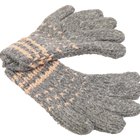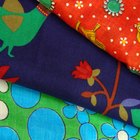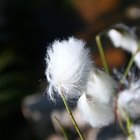
Jupiterimages/Goodshoot/Getty Images
When dressing for the winter, certain fabrics will be more successful than others at keeping the wearer sufficiently warm. Paying attention to what material your clothes are made of will go a long way to making sure you stay comfortable when spending time outside during the colder months of the year. With some tips and know-how, keeping warm during the winter will be easy and stress-free.
Wool

Digital Vision./Digital Vision/Getty Images
Wool is one of the most insulating fabrics, making it ideal for winter clothing. Some wools are tightly woven, making it a good fabric for wind resistance, and it releases moisture slowly. This means the wearer can sweat from the warmth of his or her clothing without the wool causing a chill. Popular wool items include sweaters, scarves and mittens. Wool is characterized by an elastic, woven fiber, and is taken from animals of the Caprinae family, usually sheep.
Fleece

Digital Vision./Digital Vision/Getty Images
Fleece is a synthetic fabric, typically made of a plastic material like polyester. It is a good insulator, and dries very quickly, making it a good option for those who will be exposed to snow and ice, like skiers or mountain campers. Fleece can be made thin, so it is a good layering fabric, though it is not the best wind resistor. Because of this, fleece clothing is sometimes backed with a more wind resitant fabric. Popular fleece items include scarves, gloves and jackets.
Cashmere

Evan Agostini/Getty Images Entertainment/Getty Images
Cashmere's makeup is similar to wool, but a popular substitute as it can sometimes feel softer and less itchy than wool, though it is typically more expensive. Cashmere typically comes from the cashmere goat. Though cashmere is lightweight, it still acts as a good insulator, as its fibers are tightly woven. Many different types of winter clothes can be made out of cashmere, including scarves, sweaters and dresses.
Silk

Jupiterimages, Brand X Pictures/Brand X Pictures/Getty Images
Silk can sometimes be associated with warmer months, as it is sometimes used for light clothing like camisoles, but is also useful in the winter as an insulator. Though a thin fabric, silk is one of the most tightly woven fabrics, and when worn close to the skin, can act as a good warming fabric. Silk is a protein fabric, usually made from the cocoons of moth caterpillars. In the winter, silk clothing can include long john underwear, pajamas and scarves.
Down

Michael Turek/Photodisc/Getty Images
Down is often thought of as a good choice for pillows or comforters, but is also a successful fabric for winter clothing, especially coats. Down feathers are a natural insulator, and are commonly used inside a quilted fabric for cold-weather clothing like ski outfits. One factor to consider is that down feathers tend to stick together when wet by snow, so it's important that down is protected by a water resistant fabric, typically a synthetic material.
Related Articles

Down vs. Wool for Warmth in Coats

Microfiber vs. Cotton Clothes

Differences Between Polyester and Nylon ...

Fabrics Similar in Weight to Taffeta

The Advantages of Wool Clothing

Natural Vs. Synthetic Clothing

What Can I Do to Prevent a Wool Coat ...

The Differences Between Fleece & ...

What Is the Warmest Lining for Winter ...

Goose Vs. Duck Down Pillows

The Advantages of Polyester Cotton

What Is Arnel Vintage Material Fabric?

Why Cotton Is Used in Clothing

Which Fabrics Are Most Fire Resistant?

What Is Berber Fleece?

What Is Fleece Fabric Made From?

Can a Wool Coat Be Worn in the Rain?

Define Cotton Silk Fabric

Nylon vs. Cotton Panties

What Do Chinese Women Wear?
References
Writer Bio
Erica Morris has six years of journalism experience, working for publications in New York, London and South Florida. She has served as associate editor for a Jewish lifestyle magazine in Florida for the past two years, and worked as both a news and features writer for a number of weekly newspapers.
Photo Credits
Jupiterimages/Goodshoot/Getty Images